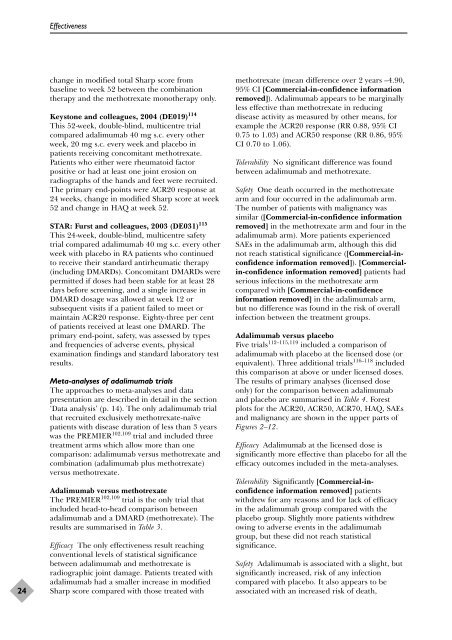A systematic review of the effectiveness of adalimumab
A systematic review of the effectiveness of adalimumab
A systematic review of the effectiveness of adalimumab
You also want an ePaper? Increase the reach of your titles
YUMPU automatically turns print PDFs into web optimized ePapers that Google loves.
24<br />
Effectiveness<br />
change in modified total Sharp score from<br />
baseline to week 52 between <strong>the</strong> combination<br />
<strong>the</strong>rapy and <strong>the</strong> methotrexate mono<strong>the</strong>rapy only.<br />
Keystone and colleagues, 2004 (DE019) 114<br />
This 52-week, double-blind, multicentre trial<br />
compared <strong>adalimumab</strong> 40 mg s.c. every o<strong>the</strong>r<br />
week, 20 mg s.c. every week and placebo in<br />
patients receiving concomitant methotrexate.<br />
Patients who ei<strong>the</strong>r were rheumatoid factor<br />
positive or had at least one joint erosion on<br />
radiographs <strong>of</strong> <strong>the</strong> hands and feet were recruited.<br />
The primary end-points were ACR20 response at<br />
24 weeks, change in modified Sharp score at week<br />
52 and change in HAQ at week 52.<br />
STAR: Furst and colleagues, 2003 (DE031) 115<br />
This 24-week, double-blind, multicentre safety<br />
trial compared <strong>adalimumab</strong> 40 mg s.c. every o<strong>the</strong>r<br />
week with placebo in RA patients who continued<br />
to receive <strong>the</strong>ir standard antirheumatic <strong>the</strong>rapy<br />
(including DMARDs). Concomitant DMARDs were<br />
permitted if doses had been stable for at least 28<br />
days before screening, and a single increase in<br />
DMARD dosage was allowed at week 12 or<br />
subsequent visits if a patient failed to meet or<br />
maintain ACR20 response. Eighty-three per cent<br />
<strong>of</strong> patients received at least one DMARD. The<br />
primary end-point, safety, was assessed by types<br />
and frequencies <strong>of</strong> adverse events, physical<br />
examination findings and standard laboratory test<br />
results.<br />
Meta-analyses <strong>of</strong> <strong>adalimumab</strong> trials<br />
The approaches to meta-analyses and data<br />
presentation are described in detail in <strong>the</strong> section<br />
‘Data analysis’ (p. 14). The only <strong>adalimumab</strong> trial<br />
that recruited exclusively methotrexate-naïve<br />
patients with disease duration <strong>of</strong> less than 3 years<br />
was <strong>the</strong> PREMIER 102,109 trial and included three<br />
treatment arms which allow more than one<br />
comparison: <strong>adalimumab</strong> versus methotrexate and<br />
combination (<strong>adalimumab</strong> plus methotrexate)<br />
versus methotrexate.<br />
Adalimumab versus methotrexate<br />
The PREMIER 102,109 trial is <strong>the</strong> only trial that<br />
included head-to-head comparison between<br />
<strong>adalimumab</strong> and a DMARD (methotrexate). The<br />
results are summarised in Table 3.<br />
Efficacy The only <strong>effectiveness</strong> result reaching<br />
conventional levels <strong>of</strong> statistical significance<br />
between <strong>adalimumab</strong> and methotrexate is<br />
radiographic joint damage. Patients treated with<br />
<strong>adalimumab</strong> had a smaller increase in modified<br />
Sharp score compared with those treated with<br />
methotrexate (mean difference over 2 years –4.90,<br />
95% CI [Commercial-in-confidence information<br />
removed]). Adalimumab appears to be marginally<br />
less effective than methotrexate in reducing<br />
disease activity as measured by o<strong>the</strong>r means, for<br />
example <strong>the</strong> ACR20 response (RR 0.88, 95% CI<br />
0.75 to 1.03) and ACR50 response (RR 0.86, 95%<br />
CI 0.70 to 1.06).<br />
Tolerability No significant difference was found<br />
between <strong>adalimumab</strong> and methotrexate.<br />
Safety One death occurred in <strong>the</strong> methotrexate<br />
arm and four occurred in <strong>the</strong> <strong>adalimumab</strong> arm.<br />
The number <strong>of</strong> patients with malignancy was<br />
similar ([Commercial-in-confidence information<br />
removed] in <strong>the</strong> methotrexate arm and four in <strong>the</strong><br />
<strong>adalimumab</strong> arm). More patients experienced<br />
SAEs in <strong>the</strong> <strong>adalimumab</strong> arm, although this did<br />
not reach statistical significance ([Commercial-inconfidence<br />
information removed]). [Commercialin-confidence<br />
information removed] patients had<br />
serious infections in <strong>the</strong> methotrexate arm<br />
compared with [Commercial-in-confidence<br />
information removed] in <strong>the</strong> <strong>adalimumab</strong> arm,<br />
but no difference was found in <strong>the</strong> risk <strong>of</strong> overall<br />
infection between <strong>the</strong> treatment groups.<br />
Adalimumab versus placebo<br />
Five trials 112–115,119 included a comparison <strong>of</strong><br />
<strong>adalimumab</strong> with placebo at <strong>the</strong> licensed dose (or<br />
equivalent). Three additional trials 116–118 included<br />
this comparison at above or under licensed doses.<br />
The results <strong>of</strong> primary analyses (licensed dose<br />
only) for <strong>the</strong> comparison between <strong>adalimumab</strong><br />
and placebo are summarised in Table 4. Forest<br />
plots for <strong>the</strong> ACR20, ACR50, ACR70, HAQ, SAEs<br />
and malignancy are shown in <strong>the</strong> upper parts <strong>of</strong><br />
Figures 2–12.<br />
Efficacy Adalimumab at <strong>the</strong> licensed dose is<br />
significantly more effective than placebo for all <strong>the</strong><br />
efficacy outcomes included in <strong>the</strong> meta-analyses.<br />
Tolerability Significantly [Commercial-inconfidence<br />
information removed] patients<br />
withdrew for any reasons and for lack <strong>of</strong> efficacy<br />
in <strong>the</strong> <strong>adalimumab</strong> group compared with <strong>the</strong><br />
placebo group. Slightly more patients withdrew<br />
owing to adverse events in <strong>the</strong> <strong>adalimumab</strong><br />
group, but <strong>the</strong>se did not reach statistical<br />
significance.<br />
Safety Adalimumab is associated with a slight, but<br />
significantly increased, risk <strong>of</strong> any infection<br />
compared with placebo. It also appears to be<br />
associated with an increased risk <strong>of</strong> death,
















